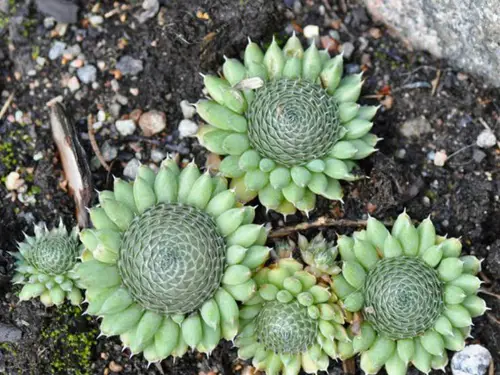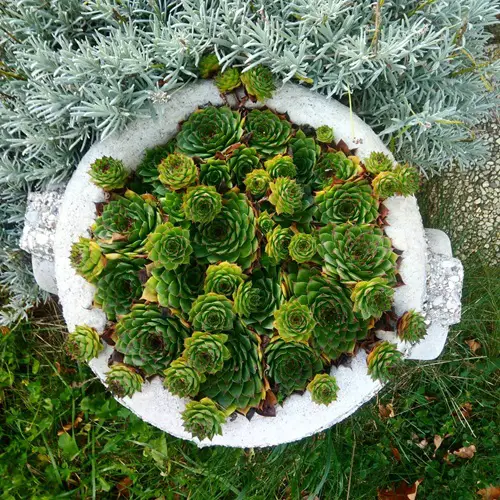Freeze-proof your garden with these Frost Tolerant Succulents! Learn about plants that defy the cold while staying beautiful all winter long.
Succulents are renowned for their extreme adaptability and temperature hardiness. But did you know that certain ones can even thrive in frosty conditions? While most plants succumb to such low temperatures, we have picked out the best succulents that can be grown outdoors even in the coldest months of the year! Check them out for an “icy” surprise!
Best Frost Tolerant Succulents
1. Hens and Chicks
Botanical Name: Sempervivum tectorum
USDA Zones: 3-8
Starting off the list strong with Hens and Chicks, which are impressively frost-tolerant. These succulents are native to higher altitudes, precisely the mountains of southern Europe. This region of origin has helped them evolve to withstand sub-zero temperatures with some accounts stating that they can survive in -30 F (-34 C). However, they usually thrive in a much milder temperature range of about 65-75 F.
You can identify this plant by its iconic colors, rosettes that come in green, purple, or red. Their physical form hides the secrets of their cold hardiness as their thick, water-retentive leaves and natural protective wax keep them healthy in low temperatures.
2. Stonecrop

Botanical Name: Sedum
USDA Zones: 3-9
These herbaceous succulents can handle freezing temperatures down to -20°F (-29°C). They have small, fleshy, and rounded leaves and they grow close to the ground. This mounding growth pattern and clustered, dense growth allow them to keep growing even when covered with a slight layer of frost.
Going into the specifics of their morphology, they catch the eye easily due to the green, blue, or red shades of the plump leaves (depending on the variety) and their small, star-shaped flowers. They are master adaptors and have proven to be resistant to dry soil, foot traffic, drought-like conditions, and heat.
3. Parry’s Agave

Botanical Name: Agave parryi
USDA Zones: 5-10
Despite being from the deserts of North and Central America, the Parry’s Agave does equally well in cold conditions as hot ones. As a matter of fact, the Parry’s Agave can comfortably grow even when the mercury level dips to -20 F (-29 C).
You will need a bit of space to grow this winter succulent, as each sword-like leaf in this rosette-forming plant can reach several feet. They also produce flower stalks from the center of the rosette that can extend to 10-15 feet in height. Its thick, waxy leaves retain moisture, helping it endure in both cold and arid climates.
4. Spiny Pennywort

Botanical Name: Orostachys spinosa
USDA Zones: 4-9
Spiny Pennywort has a unique appearance. It has inward curling thick, fleshy leaves that are originally greenish and take a darker shade in cooler weather. They are quite compact and can survive temperatures down to -20 F, making them highly frost-tolerant.
It is not very choosy when it comes to its growth requirements and does well in full sun, average well-draining soil, and little to no fertilization. The peculiar shape and temperature-resistant qualities make it a must-have in your garden to retain its glory in the winter seasons.
5. Ice Plant

Botanical Name: Delosperma cooperi
USDA Zones: 5-9
You would think a plant native to hot regions such as Yemen, Africa, and Saudi Arabia, but the Ice Plant breaks that stereotype. Another common misconception is its common name, which comes from the tiny hairs on their leaves and stems that refract light, giving them an illusion of being covered with ice crystals. However, they don’t mind actually being covered in a slight frost as they can survive in freezing temperatures down to -20 F (-29 C).
This low-growing succulent shares many similarities to stonecrop due to its small, rounded, fleshy leaves and bright, daisy-like flowers. However, these flowers, which bloom from summer through fall, are much showier due to their bright coloration.
6. Spanish Dagger

Botanical Name: Yucca gloriosa
USDA Zones: 6-11
Spanish Daggers are known for their resistance to heat and arid conditions, but they display the same hardiness in colder environments as well. They can be seen flourishing in temperatures down to around -4 F (-20 C). However, they are not often grown in regions where the temperatures dip this low. They are more common in coastal areas due to their high salinity tolerance.
This succulent can be grown as a tree or shrub due to its large form. It has thick, sword-like green leaves that are sharp at the edges and will eventually grow a woody trunk-like structure.
7. Prickly Pear Cactus

Botanical Name: Opuntia ficus-indica
USDA Zones: 3-11
Prickly Pear Cactus is a true marvel and a treat to the eyes, even when covered with frost. This colossal succulent has large paddle-like spiny leaves and can grow up to 20 feet tall. It also produces yellow or pink flowers and edible fruits.
They usually need low temperatures to bloom, but did you know that -30 F wouldn’t pose a problem for this cactus? The prickly pear cacti prefer full sun and well-drained acidic soil. Once grown, they are salt—and deer-tolerant and can be displayed in various ways, from border plants to mass planting.
8. Ghost Plant
Botanical Name: Graptopetalum paraguayense
USDA Zones: 8-11
Ghost Plant is a member of the jade family, which is not usually known to be frost-tolerant, but this succulent is an exception. It can deal with low temperatures up to 15 F (-10 C) but is normally found in warmer conditions.
It has multicolored rosettes with each leaf having a majority of greenish-blue and pink at the tips. This plant also has a powdery covering, which helps it thrive in harsh conditions (especially hot regions).
Have you grown any of these Frost Tolerant Succulents in your garden? Share your experiences, tips, and winter gardening hacks in the comments below!








